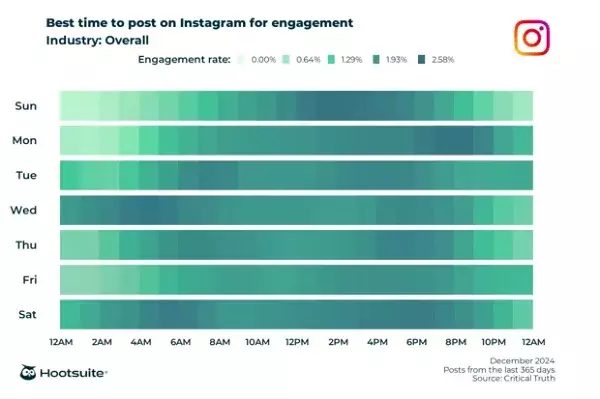In the fast-paced world of social media, one question looms large for businesses and influencers alike: When is the best time to post? It’s a question riddled with complexities and nuances. Factors such as the target audience, industry specifics, geographical location, and even the nature of the content being shared all come into play. An effective posting strategy isn’t just about hitting a “best time” mark; it’s about understanding your unique audience and adapting to the shifting tides of engagement rates throughout the day.
Recently, a comprehensive analysis conducted by Hootsuite has unveiled a treasure trove of insights into this very dilemma. By examining over a million posts across various platforms, they’ve attempted to unravel the mystique surrounding optimal posting times. While this data doesn’t provide a one-size-fits-all answer, it does offer a foundational blueprint that can guide your strategy.
Instagram: Capitalizing on Off-Hours
For those navigating the vibrant realm of Instagram, the findings suggest that the prime posting times sit between 3 PM and 9 PM on Mondays—an appealing window as it catches users unwinding after work. Tuesday mornings, particularly from 5 AM to 8 AM, and later in the afternoons between 3 PM and 7 PM also demonstrate strong engagement rates. This suggests that users are not just passive scrollers but are actively looking for engaging content during their commutes or while relaxing after work.
Moreover, a notable peak occurs on Thursdays from 5 PM to 7 PM, which further emphasizes the theory that users engage more frequently outside traditional working hours. As brands and marketers, it is imperative to recognize this pattern: the outside-of-work stimulation where users are more inclined to interact with your content, likely due to fewer distractions and a more relaxed state of mind.
Facebook: The Early Bird Gets the Engagement
Transitioning to Facebook, the results paint a stark contrast. The best times to post are predominantly early mornings—between 4 AM and 6 AM from Tuesday to Friday. This peculiar timeframe may imply that users check their feeds during their morning routines or commutes, capitalizing on quieter hours when competition for attention is low. Yet, this invites a fresh discussion: as more businesses learn about these “golden hours,” will the fleeting opportunity for engagement diminish simply due to increased posting by others? It’s a cyclical conundrum where the increasing awareness of optimal times must be balanced with the risk of flooding these time slots with content.
LinkedIn and TikTok: Professional and Creative Peaks
Switching gears to LinkedIn, the platform shines during specific intervals: Tuesday mornings, Thursday evenings, and the early hours of Friday are prime for professional engagement. Engaging an audience of professionals requires a nuanced understanding of when they’re most receptive. This could explain the uptick in activity on these specific days, aligning with workplace schedules and networking habits.
On the creative side, TikTok shifts the paradigm with stronger engagement observed in the afternoons. The spontaneity of TikTok users, often driven by entertainment and leisure, highlights the fluidity required in catering to different social media platforms. Given its unique user demographic, brands must leverage these afternoon peaks while curating content that resonates with the playful spirit of TikTok.
The Quiet Rising Star: Threads and Pinterest
Moreover, platforms are continuously evolving, with emerging networks like Threads presenting their own trends. According to Hootsuite’s research, the sweet spot for posting is at 8:00 AM PST on Tuesdays. Similarly, Pinterest thrives with engagement during lunchtime hours—particularly 12 PM PST on both Tuesdays and Fridays. For marketers, recognizing the specific characteristics of these platforms can help steer content creation.
As social media continues its rapid metamorphosis, understanding engagement patterns is an essential part of a successful online strategy. There’s no foolproof formula, but the research provides visibility into trends that can fine-tune posting strategies.
Ultimately, while data can provide a valuable guide, the key lies in experimentation and continuous adaptation to your own audience’s behaviors. Rather than rigidly adhering to the suggested times, take these insights to inform a broader, more dynamic social media strategy that resonates deeply with your community. The digital landscape is vast, vibrant, and ever-changing—your timing can make all the difference in cutting through the noise and fostering meaningful connections.

